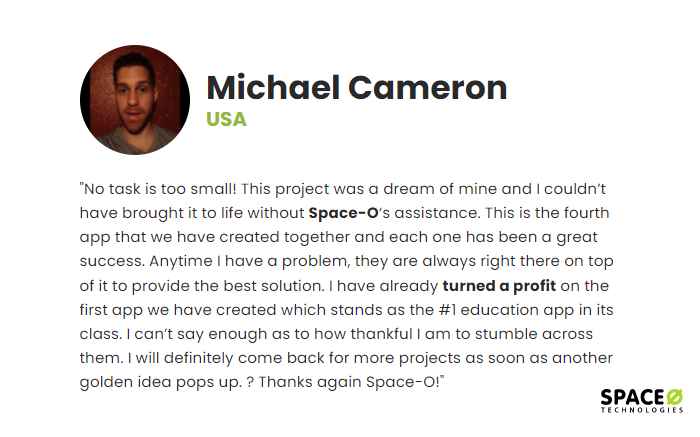If you Google best language learning apps, you would find Duolingo, ELSA AI Tutor, Babbel, Drops, and Mondly.
But the question comes to why develop language learning apps?
How developing a language learning app will help you make money?
You will be shocked to know that in the USA, the e-learning market is about to grow to $72.41 billion between 2020 and 2024. Is this information enough to convince you to develop your own Duolingo-like app?
Because this data clearly suggests that there is a growing e-learning market in upcoming years. You will have a chance to make actual money by developing your own language learning app.
But, for edtech startups, the question comes how to create a language learning app like Duolingo and monetize it.
We at Space-O technologies have more than 10 years of experience developing various types of language learning applications. This includes education to language learning apps. After discussing with our app development team, we have mentioned the complete language learning app development process along with its timeline and cost.
Let us go through each phase one by one.
Table of Contents
How To Create a Language Learning App Like Duolingo
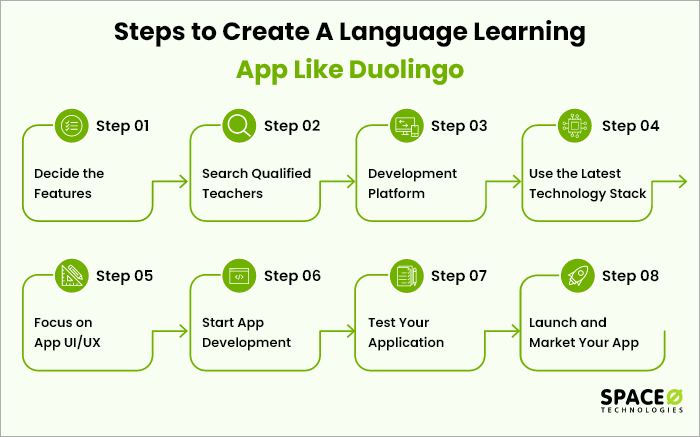
The language learning mobile app Duolingo has a total of 9.6 million daily active users in 2021. If you have decided to create an app that will make a difference to learners, you can get inspired by the success of the Duolingo app. Even the mobile educational apps in the USA are helping the entire education system.
Being an experienced app development team, we have built multiple language learning applications and will help you to create your own language app too. When a client contacts us for developing a language learning app, we follow these 8 steps to convert it into a reality.
Decide on What are You Planning to Provide
Having a clear idea about how you want to develop your educational mobile app is crucial. There are many educational app ideas, which will help your startup idea into reality. Planning exact functionalities and features will help you what your application will do at the functional and appearance levels.
Each feature should be developed targeting the end-user.
In your case, it will be new language learners. You need to consider the point of view of students and learners and develop the mobile app accordingly.
Start by penning down your thoughts about how you want your application to look and function. Whether you want to provide foreign language courses or specific language courses. It is essential for you to be clear about why you are developing the app and who will be your target audience.
Find the Qualified Teachers
Once you clearly define your goals and answer each question, the next step will be to search for qualified teachers. Discussing your app idea with a teacher will help you understand what courses to include, how to teach, and on what topic to emphasize.
Your goal should be to offer proven educational resources and quality content to learners and gain their trust. Whatever content you upload, always focus on two-way communication with your audience.
Determine the App Development Platform
Are you planning to develop a mobile application on the Android or iOS platform? In the online language learning market, the platform determines the success of your mobile app. There are over 2.3 billion Android users worldwide. The iOS users are more than 1 billion.
The reason behind selecting the app development platform depends upon the geographic location, app development time, and development complexity as well. Also, your location matters while selecting the app development platform. Since the USA holds half of the market share of iPhones, you may choose to develop your app in iOS initially and move forward with Android later on.
Use the Latest Technology Stack
You need to plan the tech stack depending upon the app development platform you have chosen. Both Android and iOS comprise different tech stacks and app development methods. Please check the table below to understand what tech stacks are used for Android and iOS.
- Storyboard
- XIB
- SwiftUI
- XML
- Swift
- Objective C
- Java
- Kotlin
- Xcode
- iOS SDK
- Android Studio
- Android SDK
- Cocoapods
- Swift Package Manager
- Coredata
- SQLite
- SQLite
- RealM
Focus on the UI/UX Part of the App
Designing a faulty mobile application results in app uninstallation. Knowingly or unknowingly you might have uninstalled the app from your phone because of the inaccurate design. As an entrepreneur, you should know that popular language learning apps designs are heavily influenced by implementing the right design principles and rules.
Here are some of the key components you should implement while designing mobile applications.
The Architecture of Information
This means providing a top-level navigation experience while accessing educational content in the mobile app. In short, adding hierarchy-wise information content defines the architecture of information.
Interaction Design
After the concept of the mobile app is final, the next step is to design an app conceptually. It includes icons, fonts, images, and aesthetics.
Usability
Does the app provide the exact information a user wants? Usability helps users to find the exact information they want.
Wireframe
The wireframe is about designing an app sample to determine how the app will work. You can test the look and feel of the app before getting it live for the public.
Visual Design
Whenever the user interacts with an application, they check many elements from icons, colors to images and fonts. But the main thing is how the app is offering a unique appearance to users and stands out from the crowd.
Develop a Language Learning Application
After implementing the design and planning out the content, the next step will be to develop a fully functional language learning application. In case, if you are short of budget, you may go for the MVP version of the mobile app development too.
Initially, offering a free language learning subscription will help you to get initial users to your mobile app. We have helped one of our clients to develop an educational app to learn Japanese where students can count objects in the Japanese language. Let’s discuss the app development session.
The app development session will be divided into 2 parts.
- Front-end App Development
- Back-end App Development
Front-end App Development
After completing the pre-design stage, the app goes into the front-end app development. The approved design will be later built into a complete app design. Mainly the front-end app development technologies include HTML, CSS, and JavaScript.
Back-end App Development
Back-end app development includes all the processes. Whenever you type a request in the browser, the request will reach where the algorithm processes the data and gives you the specific output. Different technologies like PHP, Python, Laravel are used for backend development.
One thing to note here, only implementing front and back end development alone won’t help your app to succeed. It is gamification that will make your application usable.
Education apps use gamification to offer an enhanced learning process to users. Learning a new language is hard, but gamification makes it easier by allowing users to offer a game-like experience.
For example, Duolingo allows you to compete against other learners, offers leaderboards, leagues, experience points (XP), progress bars to help you experience that you are directly competing against another human being via the app.
Test Your Application
Once your mobile app is built, you should test it for bugs and make your application error-free before launching it for the public. It is the initial stage of app development, QA will introduce you to the weaknesses and loopholes of the application.
You have the option to develop the complete app with essential features and test it with QA to find the defects in the mobile app. Without solving each bug and issue, you should not move forward with the launching of the mobile application. Because uploading an app with errors will result in failure.
Launch and Market Your App
After successfully testing the mobile app, it is time to launch your language learning application. However, launching a single app is not the end, but the start of your business.
You need to market your application on different social media platforms and introduce your mobile application to your business website as well to attract relevant traffic.
Apart from strategies, you may follow these methods to market your language learning application.
- Write a blog or guest post
- Create a landing page
- Create video introduction and teaser
- App store optimization
- Offer promo, coupons, and discounts
- App reviews
We have even developed a video app for kids – Juvi, which comes with video monitoring services that show filtered content and a time tracker to monitor content consumption. Here is a testimonial of one of our clients.
Michael Cameron wanted to build an education app that stands out from the competitors. The client was highly impressed by our team’s communication and app development skills. Check the complete client’s testimonial here.

| Development Type | iOS App Development | Android App Development |
|---|---|---|
| Design | ||
| Programming Language | ||
| Toolkit | ||
| Dependency Management | – | |
| Database |
Decided to Develop a Learning App with Duolingo-like Features?
Validate your app idea from the experts and get a free quote.

How Much Does It Cost to Develop a Language Learning App?
We have divided the cost into two parts.
In the below table, check the cost of the different types of language learning application development.
| Type of Language Learning App | Approx Estimation of Full Mobile App |
|---|---|
| Static Mobile App | $20,000 |
| Dynamic Mobile App | $25,000 |
A lower or higher hourly rate doesn’t determine the quality of development. In European countries, the web development hourly rate is lower, compared to the USA.
Duolingo Business Model | How Duolingo Makes Money?
Earlier in 2011, when Duolingo was launched, they were offering all their services for free to use for their clients. So the question comes to how Duolingo grew from earning almost nothing to 250 million U.S dollars in revenue. So, the question comes to how did it happen?
Duolingo used to provide translations services to their client bases like BuzzFeed, and CNN. The company charged significantly less than its competitor just to sustain revenue. However, the current revenue stream was not enough to sustain itself. Adopting the freemium model seemed a smart decision.
Here are the different revenue streams Duolingo follows.
| Features | What Duolingo do you get? |
|---|---|
| Duolingo Plus |
|
| Advertising |
|
| Language Test |
|
Duolingo always performs A/B testing to enhance the mobile constantly. After the launch of the mobile app, instead of developing an MVP version, Duolingo gradually improved their website and mobile app and in turn, the app purchase increased by 13%. So, what improvements has Duolingo made over the years?
- Added badges as an achievement to motivate the users
- Collect badges so users get inspired to learn more
- Compete with your friends and check who has more badges
In turn, this is the result Duolingo achieved over the years.
- 13% increase in sales and 116% in friends added the list
- 4% of users started and finished increase
- 116% increase in adding friends
Ultimate Results Achieved by Duolingo
How Much Time Does It Take to Build an App Like Duolingo or Babble
We discussed with our development team to help you provide the approx time you should expect to complete the app development.
| Tasks/Features | Approx. Hours |
|---|---|
| Wireframe | 32 hours |
| Design | 40 hours |
| SRS | 17 hours |
| Test Case | 10 hours |
| iOS App Development | 220 hours |
| Android App Development | 220 hours |
| Backend Development | 160 hours |
| QA | 40 Days |
| Total Time | 739 hours |
Want to Develop a Language Learning App?
Validate your app idea with us. We have experience in developing custom educational and language learning apps.
Features to Include to Build Duolingo Similar Apps
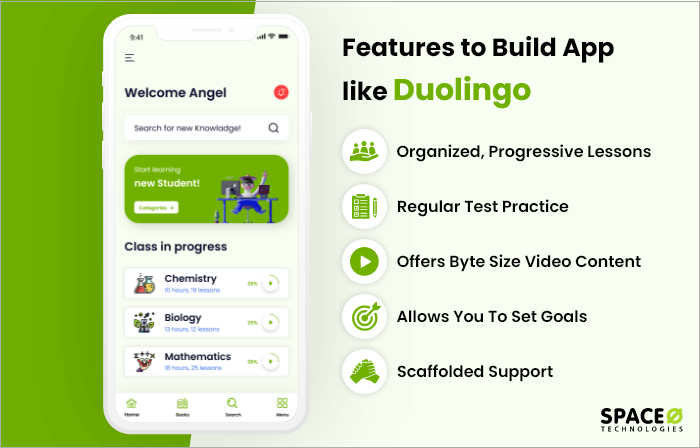
The e-learning market size has risen at 14.6%, and the e-learning market size is estimated to reach $400 billion by 2026. Even the revenue of the Duolingo app has risen over the years. In 2019 the total revenue of the Duolingo app was 70.76 million U.S. dollars, which by 2021, increased to $250.7 million U.S dollars.
The future is certainly bright for language learning mobile apps. You should know the essential features and tips to develop the language learning app. Now, the question comes, what features should you include to develop a similar app like Duolingo?
But, you might have a question about why learners prefer the Duolingo mobile app? What is so unique about the app?
Let’s discuss the 5 unique language learning app features of the Duolingo app.
Offers Organized, Progressive Lessons
Duolingo is effective in offering the best learning experience. The application offers a clearer route to complete the course step by step. As you progress with the new tutorials, new levels unlock, turning grey icons into colorized ones which shows that you have successfully completed the levels.
Regular Test Practice
Duolingo allows you to strengthen your skills by offering you program tests, which help you to sharpen your vocabulary. You will get the chance to enhance your previously learned skills and repeatedly sharpen up your skills by revising what you have learned before.
Offers Byte Size Video Content
Microlearning means dividing the content into smaller pieces. It may become harder for learners to absorb all the information in a single go. Therefore, providing bite-sized lessons is short and focused on a particular topic. Based on the information from SHIFT, microlearning increases student retention by 80%.
Allows You to Set Goals
The human mind is wavering. We sometimes forget the things we start. Therefore, the app helps you remember the goals you need to achieve to get ahead with chapters. Duolingo app allows you to set goals between casual, regular, serious, and intense. As the complexity of the goal increases, so does its timing.
Scaffolded Support
In the Duolingo app, you might have noticed that while going through the language learning courses, Duolingo provides relevant tips in between to engage learners and help them to understand the language better. That is known as scaffolded support.
All of the integrated tips (tips that popups up in between your course) are useful to increase user retention. For example, suggestions like word translations, new word suggestions are extremely helpful and the scaffolded support feature does exactly that.
| Type of Goals | Time |
|---|---|
| Casual | 5 minutes |
| Regular | 10 minutes |
| Serious | 15 minutes |
| Intense | 20 minutes |
List of Best Language Learning Apps Like Duolingo
Undoubtedly, Duolingo is a well-known language learning application. However, after researching thoroughly, we have found other applications, which are worth looking at. These are the apps that teach you different languages along with sharpening up your linguistic abilities.
| Apps | Features | Valuation | Total Users | Download |
|---|---|---|---|---|
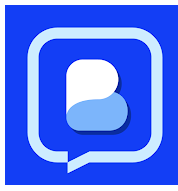 Bussu Bussu |
| $40 Million | 100 million | |
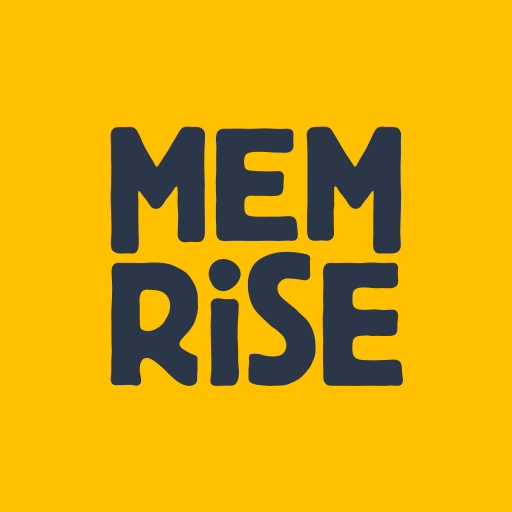 Memrise Memrise |
| $22 million | 55 million | |
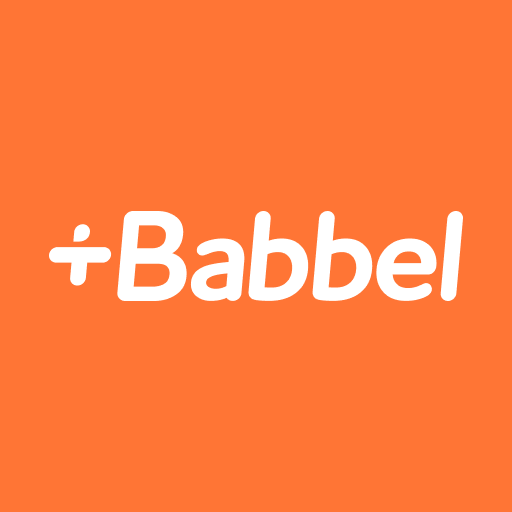 Babbel Babbel |
| $139 million | 36 million |
Bussu
More than 100 million users choose Buss to learn Spanish, French, Japanese, and 9 other languages. Bussu even includes personalized courses to help you learn the languages according to your choice. You have the chance to connect with more than 100 million native speakers, make friends and enhance your language skills. In the year 2020, Bussu generated $40 million in revenue, which was a 60% year-on-year increase.
Memrise
Memrise offers users to learn a language using hundreds of video clips that are shot by experts. Mainly, the application focuses on vocabulary. If you want to memorize irregular vocabulary, then check Memrise. Memrise is the total opposite of textbook studies. Founded in 2010, the app has quickly grown and garnered around 55 million downloads from 189 countries.
Babbel
For the last 10 years the language learning app Babbel has helped over 36 million people to learn any language they want to learn. Year by year, Babbel is able to accumulate higher revenue. In 2013, the app revenue was $14.7 million, and as of 2020, the revenue of Babbel has increased to $165.5 million.
Below we have mentioned frequently questions users ask while developing a language learning app.
FAQs About How to Create a Language Learning App Like Duolingo
What are different ways to earn money from language learning apps?
Monetizing the mobile app is the primary factor entrepreneurs consider after the app development is over. To earn money from language learning apps, follow these methods.
- In-app purchase: Buy paid services directly from the app.
- Subscription-based service: A user will buy a specific plan from the application and pay for the monthly or yearly service.
- Freemium model: After getting free app access for a limited time, the user needs to pay a monthly subscription.
- Referral program: Instead of the company, users will promote your help and in exchange, you may offer them a referral bonus.
What are the different ways to motivate your users to use your app?
To motivate your language learners consistently, your application should have all the language learning elements which are reading, writing, listening, and speaking. Here are some of the essential points to take into consideration to motivate language learners.
- Integrate gamification like XP (experience points), streak (Check for how many days you have met your XP goals), achievement feature (allowing users to check their progress and milestones).
- Offer reward points, like crowns, gems, and progress bar to help students to know where they stand
- Developing seamless learning procedure
- Offer different types of lessons
- Allow users to shop from the app
Ready to Build Your Own Language Learning App?
You have learned the complete procedure from start to finish about creating your language app. Now, it is time for you to take action and apply these steps to make your own language app. There are essential points you should remember like implementing two-way communication, adding only legit learning materials in your app, and allowing students to join the community for an enhanced learning experience.
Here are some of the educational apps we have developed. Please take a look.
- Counting Japanese: The app helps you to count different objects in Japanese in 27 ways.
- Juvi: This is a video streaming app for kids, using this app parents can monitor content kids are consuming.
Being one of the top mobile app development companies, if you need our help to develop a complete app like Duolingo, please feel free to reach out.

